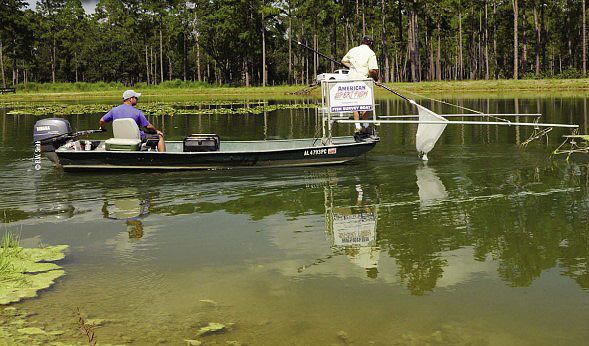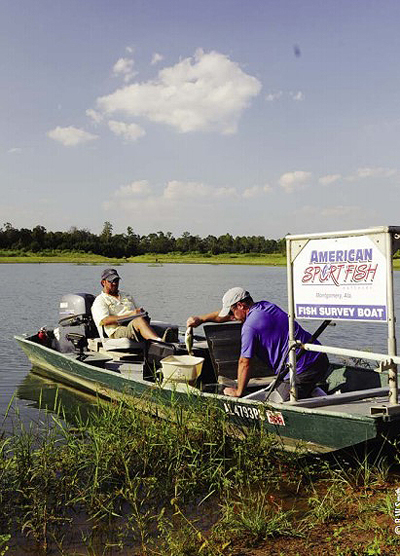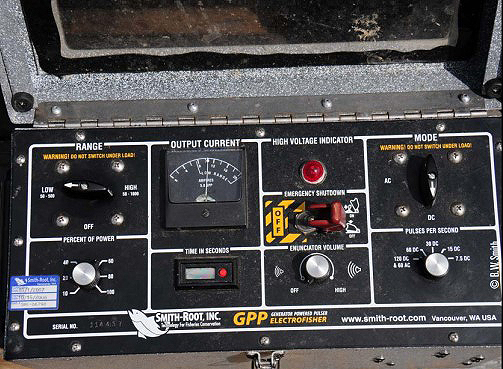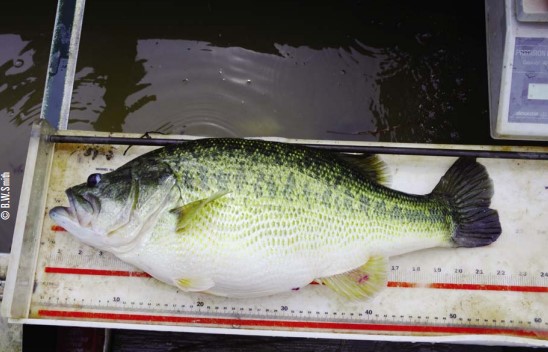Barry W. Smith | Originally published in GameKeepers: Farming for Wildlife Magazine. To subscribe, click here.

More than a half-century ago biologists were attempting to analyze fish populations to help them understand why some lakes had good fishing and in others the fishing was poor. A lot of the lakes with different fish populations appeared the same from the surface; what was going on beneath the water?
The late Dr. Homer Swingle of Auburn University in Auburn, AL, was known as the “father” of pond and small lake management in the southeast. In the late 1940s, he began developing sampling techniques, utilizing small seines, to determine the state of balance of fish populations. These techniques are still valid and are used today by many biologists.

the electrofishing sample. These data will be analyzed to
provide insight into the overall condition of the fish
population at the time of our sample and will provide a base
line of information upon which we can make management
recommendations.
During the late 1960s, there was an interest in using electricity to sample fish populations. Many years ago I used some of these primitive, home-made systems and consider myself fortunate to be here with little permanent damage. As time passed, the technology improved and in the 1970s there were several reliable commercially manufactured systems available for use in streams and lakes. Biologists began not only to sample with electricity but to figure out useful ways to analyze the information collected. Today, you can purchase a state of the art electrofishing boat for a mere $60,000 or a little more if you want really want the deluxe model.
What Is Electrofishing?
I am fortunate to travel throughout the southeast in a company truck that is a rolling advertisement for American Sport Fish. The side of my truck reads like a billboard; Stocking, Pond Management, Tiger Bass, but there is one word that generates 90 percent of the questions at fuel stops and rest areas where ever I travel. The conversation usually starts like this: “Pardon me, may I ask you a question? What is electrofishing?” Electrofishing is one of the other words printed on the side of my truck. That is a good question and I will try to give you a simple explanation of what it is and how we can use it to look at the fish population in your lake and determine how you can improve the fishing.
Electrofishing involves the placement of an electrical current in the water to temporarily stun scale fish so that they can be observed and collected to measure such parameters as length and weight. This sounds simple but it is a little more complicated than running a bare wire into the lake from the 110v outlet in your boathouse. It also is not the same as the crank telephone Uncle Joe Bob used to get catfish from the Alabama River. Aunt June said there were a couple of times when Uncle Joe Bob must have dialed the wrong number from the river because he got the game warden!
Modern electrofishing systems involve the latest technology and electrical engineering to allow the user to adjust a number of variables to effectively sample fish in a wide range of aquatic environments. There is a tremendous variation of water quality from one region to another and often one lake to another. Some waters are “soft” and have few minerals and other compounds that help conduct electricity while other waters are “hard” and may have such high mineral content that electrofishing can be difficult. Pure or distilled water is not a good conductor of electricity and it is difficult to electrofish in brackish or salt water.
There are many types of professional electrofishing units, some using large commercial gasoline-powered generators that provide 230 volts of electricity, while others use 12v generators. All of these generators route their electricity through a control box and then through a set of electrodes which are typically suspended off the bow of an aluminum boat. The control box allows the user to fine tune the output to suit the water quality and the type of fish targeted. These units may range in power from 2500 watts (volts X amperage) to more than 10,000 watts. Most pond and small lake units are from 2,500 watts to 7,500 watts.

delivered to the lake through the electrodes at the front of the boat. We can
fine-tune the settings to make our electrofishing successful for each body of
water. The box also has an emergency cutoff switch, one of the many safety
features of the boat.
What Happens to the Fish?
The fish that are stunned by the electrical current are dipped with a long-handled net with a non-conducting handle made of fiberglass or wood. The fish are placed in an aerated live well and can then be measured and weighed. Stomachs of predator fish such as bass and crappie can be examined for food content to determine what items they are eating during the time of the sample. A good biologist can make many other observations from this sample such as the overall condition and health of the forage fish, have they developed eggs and are they ready to spawn, do they have parasitic lesions or obvious bacterial infections. After examination, most of the fish are returned unharmed to the lake. Exceptions are to keep selected sizes of bass from populations that are obviously crowded. A sample of bass and crappie are often kept to remove the ear bones (otoliths) for aging. This can help determine how rapidly the fish are growing. Electrofishing does not usually kill fish, but simply stuns them.

what every lake owner expects to see. They caught and released several
10- pounders in 2004; they must be at least state records by now. They are sure
the bass are still there because they have never seen a dead bass in their lake!
What Information Is Obtained through Electrofishing?
By weighing and measuring bass, for instance, we can calculate a value called Relative Weight (Wr), which can tell us how a largemouth bass of a given length compares to thousands of other largemouth bass of the same length. Not only can we tell if bass in a certain size range are fat or skinny but we have a baseline of scientific information that can be used in subsequent years to determine if we have made significant progress in improving the condition of the fish population.
We also look at the numbers of each species of fish in each size group. With bass, for instance, we prefer to see an even distribution of sizes from small to large. Often in crowded bass populations, we see obvious peaks in numbers of fish that are 10 to 14 inches. We look at bluegill lengths and know that if there are few bluegill in the three- to five-inch range bass will not have much to eat and will be thin with Wr values 80 or below.
Electrofishing can provide information and insight into developing problems so that action can be taken before it becomes an apparent problem to the lake owner. This is one of the many advantages of having your lake managed by a reputable fisheries biologist or management company. Bass are often selectively removed from lakes that do not have much fishing pressure to help prevent crowding.
Does Electrofishing Shock All the Fish in the Lake?
Electrofishing does not shock all the fish in the lake. We typically want to obtain what we hope is a representative sample of the fish population. Depending on the conductivity of the water, the time of year and the individual electrofishing boat, this may not always be accomplished. Most electrofishing boats designed for pond or small lake work have electrodes that place a current to a maximum depth of six feet. In certain times of the year, large bass, crappie, and other species may be deeper than six feet and are thus out of the sampling range.
Many lake owners who have their lake electrofished for the first time have unrealistic expectations. They expect to see the entire trophy bass population float to the top so that we can tell them how many bass larger than 10 pounds they have in the lake. Large bass are difficult to sample for many reasons, but they are not as abundant as most lake owners think they are.
Is Electrofishing Dangerous?
You can be assured it is! We have many safety features on our boats and take the utmost precautions to ensure that our employees and lake observers are not placed in harm’s way. Read about electrofishing safety and make sure you have a trained professional electrofish your lake. Also, make sure you receive a written report that contains the data collected from your lake.
Barry W. Smith is a Certified Fisheries Scientist and travels throughout the southeast conducting many of the electrofishing surveys for American Sport Fish.































